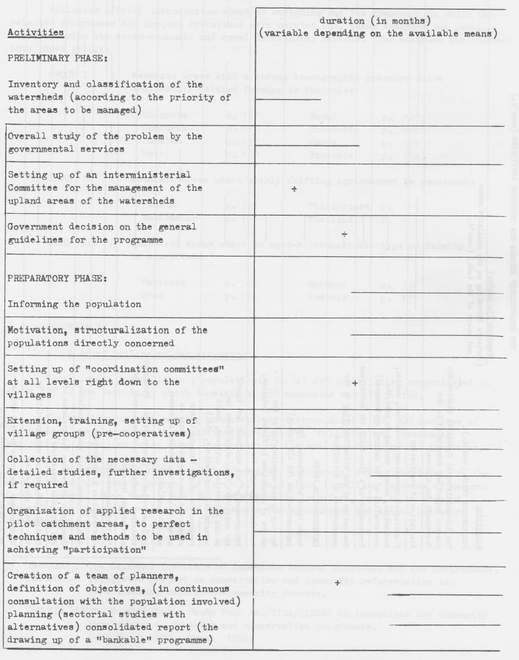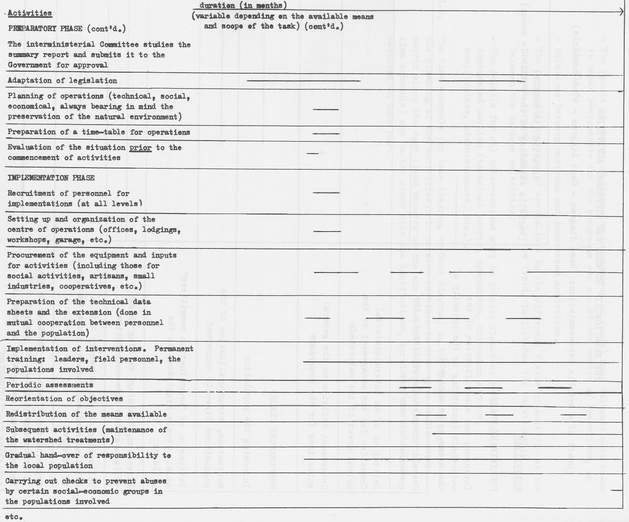in rural development programmes when managing upland areas of watersheds
PRELIMINARY PHASE:
At the beginning, there has to be a governmental decision in favor of restoring and preserving the upland zones of watersheds and as regards the general guidelines for rural development in these areas. It is a political decision, based on documentation prepared by the government's own departments.
Once this decision has been taken, there are then two possibilities:
Furthermore, the authorities may also find themselves faced with the following alternatives:
or else:
Decisions on the organization of activities and actions will be taken in the light of the above.
There may, therefore, be four different cases:
PREPARATORY PHASE:
In cases 1 and 3, the services responsible for management (The Soil and Water Conservation Service, in general), will have to reach agreement with the services handling motivation, community development, extension (agricultural, forestry, animal husbandry, etc.), to organize a national campaign to inform the population as a whole of what is going on and, more particularly, to implement a motivation programme including literacy campaigns and the structuralization of the rural world.
Such a programme requires a lot of time and entails the mobilization and coordination of all the services involved and their personnel. For this reason it would be better, at first, to consider the third case mentioned above, i.e. to concentrate efforts and resources on one or a couple of set catchment areas, selected from among the various geographical regions of the country, to act as an experiment before organizing a programme at the national level. During the experimental years, which will make it possible to refine methods of approach and the techniques for intervention, the national motivation and structuralization programme can be implemented, It will then be possible to proceed with case 2 which is the final overall objective.
The participation of many governmental and para-governmental services and bodies is essential, particularly those responsible for the following sectors: silviculture; soil and water conservation; agriculture; animal husbandry; fisheries; conservation of natural resources and protection of the environment; community development; social affairs; national customs and traditions; education and training; extension; public health and hygiene; public works; agricultural engineering; transport and communications; energy; cooperatives; credit; marketing; industry (lumber, etc., and other small scale industries); crafts and handicrafts; planning; research; finance; administration; legal affairs; ..., to mention but a few of the more important ones.
In these areas mainly devoted to forestry, it is logical that the responsibility for coordinating development activities should belong to the service in charge of forests and water and soil conservation.
If necessary this service can be reorganized and decentralized and reinforced both as regards its personnel and operating budget.
From the information received from the various partners, it is a question of creating the central machinery:
Interministerial Committee (to draw up the guidelines for the Government);
Programme Management Board (for planning and programming)
Multidisciplinary Coordination Committees at all administrative levels right down to the villages.
The creation, perhaps, of a special body for implementation of the programme.
Inventory and classification of the areas to be managed
Collect and analyse the available documentation; carry out surveys to complete the data
Determine priorities.
Draw up and implement an applied research programme, in close cooperation with the different research centres and institutes in the country. Such research work must also look at the human geography, social structures, local customs and traditions, economic conditions, production potential and identify the major constraints.
Sound out the opinions of the various groups in the populations regarding the proposed objectives and actions. Prepare alternatives to allow for constraints, both known and unexpected. (It is important to foresee activities and interventions which will bear fruit quickly and, above all, improve the lot of the least-favoured groups while causing the least disruption to their normal way of life.)
Adaptation of legislation (forestry, agrarian, and that dealing with the conservation of soils and water, cooperatives and pre-cooperatives, etc.). Preferably, consideration should be given to the drawing up of a rural code.
Planning (setting up a multi-disciplinary group of planners, defining objectives; selection of methods; sectorial studies on the basis of standard parameters, forecasting different variations, in detail; harmonization of the various interventions planned in each sector; selection of priority areas; detailed planning of rural development in these areas; inventory of the resources required, drawing up a time-table for operations; preparation of a consolidated report by the group of planners).
The populations concerned must be consulted continuously throughout this entire planning process.
It will be up to the interministerial Committee for the management of upland areas of watersheds, to consider the planning group's report; to request any complementary studies that may be required and, finally, to submit the plan to the Government for approval.
The Government will negotiate financing for the programme with the credit institutions (both national and international).
Selection of economic incentives.
Decision on what level of technology is to be adopted, (depending on the labour available and the technical difficulties that have to be overcome).
Detailed programming of operations (selection of the type of programming to be used).
IMPLEMENTATION PHASE
(economic and social aspects only, excluding technical aspects)
Intensification of the motivational and extension activities based on the subjects and themes previously selected as suitable for intervention.
Recruitment and re-training of personnel. At the managerial levels of the programme, it would be preferable to give the responsibility of implementation of the project to those who were involved in its conception and planning.
Setting up a centre of operations in the area of the programme, with offices, lodgings, workshops, garages, storage areas, meeting rooms, etc.
Ordering of equipment and the necessary inputs.
Improving communications and means of access.
Preparation of technical data sheets for each activity.
Training of farmers, foresters, herdsmen, members of community councils, village groups, cooperatives, and all those connected with the programme in keeping with the planned activities.
Training courses for field personnel.
Preparation of typical contracts for those works to be carried out in mutual agreement between the local populations and the programme.
Drawing up of rules and regulations for the village groups and the cooperatives.
Organizing the administration of the revolving fund (creation of credit committee, training of its members).
The removal or displacement of the population must be considered only as a last resort, after all other possible solutions have been discarded. In this case, preparations for the transfer and re-installation of the population must be planned well in advance and in the greatest detail.
Prepare the allocation of titles for long-term lease or ownership, if these are provided for in the programme.
Meetings to be held at frequent intervals (at least once a month of all those in charge of operations (and not forgetting representatives of the local population, to examine progress and to identify unforeseen obstacles and find the way and the means to overcome them, and to ensure coordination of the various activities and to develop a team spirit.
Regular project assessments should be made in order to compare progress with the plan of operation.
Periodically, (each month or each year, depending on the length of the programme) carry out a detailed analysis of costs and advantages, both as regards data that can be expressed in figures as well as for data which cannot be quantified. Seek solutions to problems. Re-orientate, and/or correct the plan of operations if this should prove necessary.
Submit the results of the assessments to the interministerial Committee.
N.B. If the programme has concentrated its efforts on certain priority areas within the watershed, it would be advisable to prepare beforehand for the extension of the activities to neighboring areas. In particular, this can be done step-by-step as the populations are able to take over more and more responsibility for the work of the programme.
Consideration must be given also to subsequent activities, i.e. to the transfer of, powers and responsibilities for the programme to the local population, which should be done in stages.
The programme should be carried on until the moment when activities begin to bear fruit. At this point outside help can be progressively reduced and management at the top reduced to a few advisors. However, it would be wise to maintain a permanent point of technical support in the catchment area.
Gradual take-over by the local communities of the management of this technical support point and development.
There should be frequent checks on the measures taken to improve the lot of the less-favoured populations, in order to prevent any abuses by the more-privileged groups.
N.B. The time taken for such programmes to bear fruit should be measures in generations rather than years.
THE RELATIONSHIP BETWEEN THE DIFFERENT ACTIVITIES
The relationships between technical activities are the subject of other FAO guides. Here we will mainly be concerned with the relationship between economic activities and social activities, as well as between economic and social activities on the one hand and technical activities on the other.
N.B. The time schedule (or base diagram, or Gant diagram) on the following pages shows the planning of the activities. It is also possible to draw up a double-entry matrix along the same lines showing on the one side the activities (as in this time schedule) and on the other side the institutions, services, and specialists required to take part.
THE RELATIONSHIP BETWEEN THE DIFFERENT ACTIVITIES
(Draft of a graphic representation: base diagram - Cant diagram - time schedule)

